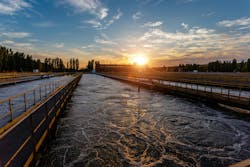One regional wastewater treatment plant in California serves a population of approximately 1.6 million and discharges treated effluent into a local river. In 2010, the facility received new, stricter state treatment and discharge requirements, which require the removal of ammonia and nitrate residuals from treated water prior to discharge.
In response to the new requirements, the facility began a major capital upgrade. This project involved upgrading the facility to include more advanced treatment capabilities and required the facility to design and build new treatment infrastructure which is scheduled for completion in 2023.
The facility reports that this project will provide “…the most significant upgrade to [the] wastewater treatment plant since its original construction…[and] will produce cleaner water for discharge to the local river [or] for potential reuse as recycled water.”
To manage the costs of this expansion while driving reliability and maintainability, the facility needed to implement strategies that would improve design, optimize capital and operational expenditures, and streamline operations and maintenance (O&M). For these reasons, the facility leaders decided to implement reliability-centered design (RCD) and reliability-centered maintenance (RCM) as a means to reduce total cost of ownership. With their end goal in mind, facility leaders sought out a third party to assist with implementing these strategies.
Pinnacle Reliability was brought in to the project during the front-end engineering design stage to facilitate an RCD analysis. Once the design was completed, Pinnacle supported the implementation of an RCM program to ensure personnel had a streamlined, safe, and cost-effective program in place prior to assuming ownership of the facilities.
RCD considers the reliability, maintainability, and O&M lifecycle costs early in the design phase. Before finalizing the design, RCD provides a complete review by key O&M staff, management, and process experts to improve performance and reduce O&M costs over a facility’s lifecycle.
RCM is a risk-based approach to identifying critical equipment and cataloging the potential failure modes and mitigation strategies prior to an asset failing. This approach is pivotal in identifying hidden failures and ensuring that preventative tasks are in place to increase asset life. The RCM analysis and subsequent results are a foundational step in all preventative and predictive reliability and maintenance programs.
Once the RCM analysis is completed, O&M tasks are prioritized based on criticality, reducing the number of redundant tasks, coordinating like tasks to reduce labor time, and optimizing spare parts inventory management. Task selection ensures that all non-essential maintenance and monitoring tasks are eliminated without sacrificing the operability and reliability of the equipment.
Results
By implementing reliability-centered principles and focusing on the total asset lifecycle, the facility now has an optimized way to maintain its equipment and a means of categorizing equipment in order to prioritize corrective maintenance activities under various conditions. This is especially important during seasonal peak wet weather inflows.
Additionally, a streamlined RCM approach that leveraged Reliabuilder©, Pinnacle’s proprietary software, projected that the facility would start to see a return on investment in only nine months. This analysis also projected that the facility would recognize an estimated $100 million in cost savings over the life of the facility, about 50 years.
Additional benefits included design improvements and optimized costs, plus increased reliability and safety.
Pinnacle worked with the facility’s program management office to identify hundreds of reliability-based, one-time opportunities for design improvements. A majority of these improvements were accepted into the final designs. The recommendations implemented during the facility’s expansion relate to engineering, process, or safety improvements, as well environment and regulatory considerations which are meant to prevent costly shutdowns or redesign issues. They also cover initial spare parts stocking recommendations for assets that are critical to process or safety, and for spare parts with long lead times that are not readily available.
From the data gathered through RCM process interviews and task selection workshops held together with the site’s personnel, Pinnacle performed analysis on process operability — which defines how critical a process is — and abbreviated the operators’ corrective actions to address any of the potential process functional failures. This focus on maintaining system-wide availability based in an operational context was used to first identify conditions which could have shut down half of one of the main treatment systems and, from there, hone in on key maintenance strategies to prevent regulatory fines that could have resulted from this scenario. A key feature of RCD and RCM processes is maximizing process uptime and availability of all assets — even during abnormal situations.
Instead of using default vendor recommendations, Pinnacle proposed a streamlined approach which only implemented the best warranty preventative maintenance on critical assets which were evaluated to have a repair or replacement value of $25,000 or greater. The total operating maintenance cost will be reduced through the implementation of reliability-centered maintenance principles and a focus on condition-based tasks.
Working with the site’s operations and maintenance (O&M) group, Pinnacle leveraged its industry experience to help optimize future spare parts inventory requirements to ensure critical parts would be available when needed. It optimized this inventory while maintaining availability and performance and reducing cost to own and operate. In general, spare parts optimization typically results in a cost reduction of around 20 to 50 percent and, in some cases, as high as 75 percent compared to buy and stock methods. Updated storage practices were recommended to keep the necessary spare parts from deteriorating due to exposure to ultraviolet (UV) radiation, electrostatic discharge, corrosive vapors, contamination, or moisture intrusion.
Increased Reliability and Safety
Job plans, preventative maintenance schedules, lock out tag out (LOTO) procedures, and other operating documents were provided to the facility to be uploaded into its computerized maintenance management system (CMMS) prior to startup so that the facility would be ready to start tracking the performance of assets and labor.
Operator rounds — in which operators take on basic maintenance tasks — were developed. Operators assisting with maintenance tasks can help minimize repair costs, reduce downtime, mitigate or eliminate safety hazards, and extend equipment life.
Per OSHA standard 1910.146, LOTO procedures are required for both proactive and corrective maintenance to be in a zero-energy state. The facility’s existing practice was to develop LOTOs as needed, and Pinnacle developed a program in which the LOTOs were predeveloped/preapproved for each repair task and linked to the job plans. This reduces mean time to repair and subsequent labor costs at the same time, while upholding a world-class safety culture.
Upon completion, the upgrade project is estimated to cost about $1.7 billion in capital expenditures and approximately $50 million in increased yearly operations and maintenance costs per year.
By implementing RCD and RCM, the expansion now has a risk-based reliability strategy built into its design and daily operations and maintenance programs. This optimized, data-driven reliability program is focused on protecting ratepayers from future utility rate increases and sustaining system performance and compliance at the lowest cost without impacting asset lifecycle costs.
As the project nears completion, the results of optimizing the labor, energy, operations, and safety requirements give the facility and the surrounding customers the security of knowing they have state-of-the-art critical infrastructure protecting their health, as well as the environmental stewardship of one of California’s most important resources at the pinnacle of efficiency. WW
Published in WaterWorld magazine, September 2022.
About the Author
Nathanael Ince
Nathanael Ince is vice president of business development at Pinnacle and is responsible for driving new business in the oil and gas, chemical, mining, pulp and paper, water/wastewater, and related industries. He has over 14 years of industry experience including consulting, project implementation, and business development. He has architected data-driven reliability programs across oil and gas, chemical, mining, and water facilities.

